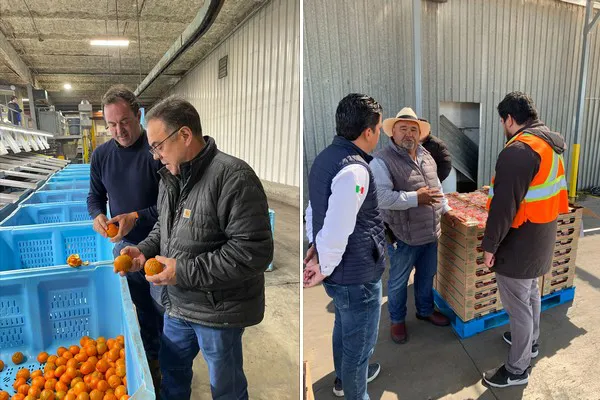Some produce varieties travel long distances to meet counter-season demand before being consumed. Lately, global trade of fresh produce has been challenging. “It has been incredibly hard to export fresh produce with the headwinds the industry has been facing,” says David Nelley with The Fresh Connection. “With everything from retaliatory tariff imposition on US produce, low crop production, high freight rates, to port congestion and significant transit delays.” However, according to Nelley there is light at the end of the tunnel as freight rates show signs of easing and equipment appears to be more available.
 Photo left: looking at California mandarins headed to New Zealand. Right: examining California strawberries bound for Asia.
Photo left: looking at California mandarins headed to New Zealand. Right: examining California strawberries bound for Asia.
Strong US dollar
What has also been having an impact on exports is a relatively strong US dollar. “Obviously, it makes produce from the US more expensive to foreign buyers. As a result, we have seen alternative sources of supply from Eastern Europe, India, and the Middle East gain market share,” Nelley commented. During this same time, the US has witnessed a strong domestic market with more fruit going to US domestic sales. As a result, a lot of our competition has dried up. “Demand is good, and select US growers have maintained a focus on export markets, and consolidated market share. Foreign buyers will remember those labels that supplied them during tight times.” Some regions like Australasia and South Africa sell in US dollars, which is positive as a strong dollar strengthens returns. “In the case of comparative returns to Euro and Sterling, our offshore offices are performing very well.”
The Fresh Connection has offices in the US, Mexico, Australia, South Africa, and Lebanon. Nelley manages the US team that’s focused on exporting North America produce to the world with a heavy emphasis on Asia, Australasia, India, Bangladesh, and the Middle East. “We also have a joint venture in Mexico with well-known Guadalajara distributor, Dubacano. This entity is called Dubafresh, exporting Mexican grown produce to the world.” Along with that, Nelley overseas procurement and sales efforts from Latin America, where produce is being sourced in mainly from Peru, Chile, Argentina and Brazil via the network of intercompany relationships such as Dole Chile and Oppenheimer.
In the US, California is in the midst of the California citrus crop right now and Nelley has been impressed with the export dedication of citrus shippers. “There is real demand for California citrus in Australasia and Asia right now” he said. “It is a similar pattern we saw during the California grape season.” It’s a dynamic time as new regions of supply are coming online with grapes and avocados, and new varieties of grapes are now available from new production sources. “With our breadth of sourcing supply and real-time market information, we are able provide options, benefiting our growers and buyers.”
 Dubacano and The Fresh Connection are partners in Mexico.
Dubacano and The Fresh Connection are partners in Mexico.
Fruit Logistica
This week, David Nelley, Will Mehrten and Roula Hadded will be attending Fruit Logistica in Berlin. “We are looking forward to seeing friends and customers as well as spending time with colleagues in the Dole PLC group of companies that has a partial ownership in The Fresh Connection.
 For more information:
For more information:
David Nelley
The Fresh Connection
Tel: (+1) 805-721-2672
david@thefreshconnection.com
www.thefreshconnection.com
